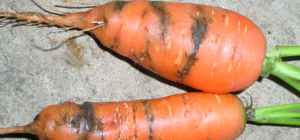FAST FACTS
Benefits and nutritional information:
- The fiber in carrots can help keep blood sugar levels under control. And they're loaded with vitamin A and beta-carotene, which there's evidence to suggest can lower your diabetes risk. They can strengthen your bones. Carrots have calcium and vitamin K, both of which are important for bone health.
Starting:
- Carrots are best planted from seeds. The soil should be well worked-up and all stones, bark or other objects sifted out since carrot roots encountering such obstacles can fork or otherwise be deformed.
- Plant seeds about 1/2” deep and 1 to 2 inches apart.
When to plant:
-
Since they grow best in cool weather, they should be planted in either early spring or late fall.
Thinning, training
-
When the plants are 4” high, thin the plants to 2” apart.
Signs of over-watering, nutrient deficiency
- Excessive watering can lead to forked roots, especially when this occurs during the first few weeks after seeding.
- It can also cause growth cracks later on in carrot development.
Pests and pest controls
- Root Maggots are the larval form of a fly. They bore tunnels through carrots and make them totally unusable.

Harvesting
- Since you can’t actually see a carrots until after it’s been harvested, knowing when to harvest requires some educated guess-work.
- Seed catalogues and seed packets list how many days it generally takes for a crop to mature. This is, of course, only a general guideline.
- Most carrots are ready to harvest when the portion visible at the soil line is from 1/2” to 3/4” in diameter. At that point, you simply have to harvest one or two in order to be certain.
- It helps to loosen the soil around carrots with a trowel before trying to pull them up. Otherwise, you may just end up with a handful of foliage.
- Trim off most of the foliage, leaving about an inch of it.
- Carrots that are left in the ground too long begin to loose their flavor and can become bitter. On the other hand, as winter approaches carrots can be left in the ground longer.
Other resources and articles
Trivia:
- The provitamin A beta-carotene from carrots does not actually help people to see in the dark unless they suffer from vitamin A deficiency. This myth was propaganda used by the Royal Air Force during the Second World War to explain why their pilots had improved success during night air battles, but was actually used to disguise advances in radar technology and the use of red lights on instrument panels.

